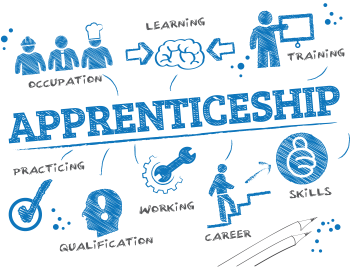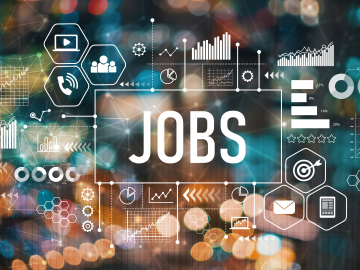
Effective workforce development policy and programs are crucial for economic growth and healthy communities, especially during a tight labor market. As a result of the current economic and workforce climate, it is no surprise that workforce development continues to be a bipartisan focus for Governors. In 2024 State of the State addresses, Governors outlined a full range of workforce development efforts, including investing in education and training programs, partnering with the private sector to align training with labor market needs, promoting apprenticeships and work-based learning, supporting adult education and upskilling programs, fostering collaboration between educational institutions, employers, and government agencies, and developing programs to allow workers to more easily access job opportunities. Below are just a few of the efforts discussed.
PreK-12 and Continuing Education

Governors recognize that a career path begins long before an individual enters the job market. As such, Governors are working to create a seamless pathway for people to acquire the skills, knowledge, and experience they need to succeed in the workforce.
- Virgin Islands Governor Albert Bryan: “The Administration remains focused on the cradle-to-career…Plans are in place to ensure that every 12th-grade student has a goal for college, technical school, military, or the workplace.”
- Idaho Governor Brad Little: “The State of Idaho has always offered support for the careers that require a four-year university degree, but we’ve historically fallen short in providing equal support to other skilled workers, jobs like trucking, linemen, firefighters, welders, plumbers, and a host of other professions that make the world go ‘round. These are good paying jobs that require specialized Training. Our new LAUNCH grants cover 80 percent of the cost, up to $8,000, to enroll in an education or training program after high school that aligns with an in-demand career. There are hundreds of career paths to choose from…Looking ahead, we have a plan to keep Idaho strong – it is called IDAHO WORKS. What we’re doing is working and the results speak for themselves, but we must never get complacent.”
- Michigan Governor Gretchen Whitmer: “We need to better prepare students for success after they graduate, whether they enter the workforce, community college, trade school, or a 4-year university. There is no ‘correct’ path. It all depends on the person. What we can do is get them ready…We must support our kids from pre-K, through postsecondary, to prosperity.”
- Virginia Governor Glenn Youngkin: “Let’s spend our time on advancing our great workforce, building on our new Workforce Development and Advancement Agency and making it easier for people to get licensed or certified to start their career by expanding universal licensing, making it easier for people moving to Virginia to get to work, and making sure every high school student has the opportunity to graduate with a diploma PLUS credential that will launch them into a high-paying job.”
- Georgia Governor Brian Kemp: “With growth comes the need for more trained workers to fill these good-paying jobs in a rapidly changing labor environment. That’s why I was proud to unveil the Georgia MATCH program at last year’s Workforce Summit. The largest direct college admissions program in the nation, Georgia MATCH is already doing an incredible job linking the upcoming generation with the school that meets their needs. As of today, over 10,000 students have already ‘met their match,’ and we will keep working to reach every high school senior in Georgia, so that they know there is a higher education path open to them right here in the Peach State, no matter their circumstances.”
- Colorado Governor Jared Polis: “We want every person in Colorado to be able to build a good life and a good career on their own terms, and we are creating many different ways to do that – from dual and concurrent enrollment to low-cost credentialing…we’ve expanded free community and technical college for in-demand careers – which has already served more than 3,500 students – nurses, construction workers, law enforcement. We’ve also partnered with businesses to develop needed training pathways, and we’ve created a pilot scholarship to support innovation in education. We are working with higher education institutions to keep tuition low through innovation and greater efficiency… we’re developing the next generation of farmers and ranchers through the Agricultural Workforce Development Program, to help young people, particularly in rural areas, get real world experience on a working farm or ranch through paid apprenticeships…We also want to continue Opportunity Now – to help “blur the lines” between K-12, higher education, and employers. And grantees are on track to serve 10,000 Coloradans in industries like construction, health care, education, and early childhood.”
- Oklahoma Governor Kevin Stitt: “A strong economy is essential to being the most business friendly state in the nation, but we also need an education system that meets our workforce needs…Technology has transformed the way we do higher education, so we can’t keep relying on 20th century education models to bring our students into the future workforce.”
Apprenticeship

Apprenticeships and earn-and-learn programs can help address skills gaps and meet the evolving needs of employers. Participating in these programs can lead to higher wages and better job prospects for workers, particularly those from underserved communities.
- Massachusetts Governor Maura Healey: “Meanwhile, our high school students are telling us that what they learn in school should help them get where they need to go. So we’ll keep growing our Early College programs, so you can go to high school and earn college credits at the same time. We’ll invest in more Innovation Pathways that provide hands-on learning in skills that set you up for great careers. We’ll connect all our students to lifelong opportunities, whether college or skilled careers. And it will be great for our workforce and our economy.”
- South Dakota Governor Kristi Noem: “We are creating opportunities for people to get into the career of their dreams. Last year, we announced an effort to expand apprenticeship opportunities for professions across the state. We wanted to give workers the opportunity to get trained for a career while still bringing home a paycheck. We wanted to give businesses the support they need to start and expand apprenticeship programs. In just the first two quarters since launching the expanded effort, we’ve more than doubled the amount of new apprenticeships from recent years. And we’re just getting started.”
- New Jersey Governor Phil Murphy: “We have doubled the number of apprenticeship programs in New Jersey. And they are helping everyone — from displaced workers to recent graduates — find their ticket to a good-paying career. And perhaps most importantly, they are creating opportunities for our state’s veterans — who deserve every possible form of support and care we can provide.”
- Pennsylvania Governor Josh Shapiro: “My Administration has registered 33 new apprenticeship programs and enrolled nearly 6,000 new apprentices statewide…We’re giving Pennsylvanians the freedom to chart their own course and the opportunity to succeed. So let’s keep at it. That’s one of the reasons why I want to create a new ‘Career Connect’ program to connect employers with talented young people and create thousands of internships over the next 10 years…Because let’s remember: there are many paths to success after high school…We need to respect all paths to opportunity equally, and we need to invest in them.”
- Missouri Governor Mike Parson: “When the history books tell the story of Missouri’s 57th Governor, I hope it’s our workforce development and infrastructure accomplishments that stand out…In this year’s budget, we included another 3 percent core increase for our four-year institutions and community colleges AND $54 million dollars for MoExcels workforce training programs on our college campuses. When I graduated high school, I went straight into the workforce and joined the United States Army…and for me there was no turnin’ back. My path is similar to many Missourians, as nearly 60 percent of our workforce don’t have college degrees. AND that’s okay because we all know it doesn’t take a college education to be successful. Since 2018, we have helped establish, upgrade, and transform 57 career and technical education institutions across our state. More of our young people are earning a quality skill, certificate, or credential that will help secure them a good-paying job without a college degree. We are also upskilling our current workforce and helping them secure the skills they need to succeed. Under our administration, yearly apprenticeship activity in Missouri has grown by 100 percent. That’s why this year we are including another $3 million dollar investment to support even more youth apprenticeship opportunities.”
- Maryland Governor Wes Moore: “When our young people get the tools they need to strengthen their minds and hearts, they grow up to dream and lead. That’s why we must build stronger pathways to success for our young people, no matter the road they choose. We need to work with our friends in labor and business to grow apprenticeships and job training.”
Targeted Industries

Given the dynamic nature of the economy and rapid technological advancements, Governors recognize the importance of upskilling and reskilling opportunities to help workers adapt to the changing demands of priority industries. At the 2024 NGA Winter Meeting, Kentucky Governor Andy Beshear and Wyoming Governor Mark Gordon led an Economic Development and Revitalization Task Force meeting to discuss “Governors’ Investments to Build a Strong Workforce in Emerging Sectors.”
- Rhode Island Governor Dan McKee: “Cybersecurity is a rapidly growing field with thousands of unfilled positions. The Cybersecurity Institute at RIC is equipping the next generation of cybersecurity professionals with the technical and business skills to meet the cybersecurity challenges of the 21st century. To meet the potential that this field offers – I’m calling on us to take it to the next level. Let’s pass a first-of-its-kind cybersecurity bond to grow RIC’s current cybersecurity program into a cybersecurity school of choice.”
- Alaska Governor Mike Dunleavy: “We’ve worked with University leadership to fulfill their mission. That mission is to prepare students for the jobs of today such as nursing and STEM fields, and the jobs of the future in emerging energy technologies, Arctic research, unmanned aircraft, mariculture, and more.”
- Arizona Governor Katie Hobbs: “With our investments in Future48 workforce accelerators, we will prepare thousands of Arizonans every year for jobs building our nation’s future in industries like semiconductors, renewable energy, and aerospace and defense.”
- South Carolina Governor Henry McMaster: “The demand for a trained EV workforce is outpacing the number of qualified applicants…To meet this demand, my Executive Budget recommends $50 million to create specialized ‘EV training institutes’ at our technical college campuses.”
- Alabama Governor Kay Ivey:” The mission of workforce development must be to recruit, train, employ and retain Alabamians into high-demand jobs…Last year, I introduced the idea of the Alabama School of Healthcare Sciences. We used our successful School of Cyber Technology and Engineering, as well as our other specialty schools, as the blueprint. This school will directly expose young men and women from around Alabama, and particularly rural students, to various healthcare fields.”
- Hawai`i Governor Josh Green: “For years, our state has struggled with a severe shortage of doctors, nurses, and other healthcare professionals — so on September 9th, we announced a groundbreaking loan repayment program to address this crisis… We’ve already received thousands of applications for this program, which we will prioritize choosing those with deep ties to our state — and just weeks ago we announced our first 585 HELP healthcare champions. This year we are placing an extra emphasis on selecting mental health and addiction treatment professionals to address heightened concerns that have arisen from the COVID era and the disaster on Maui.”
- West Virginia Governor Jim Justice: “We put $48 million into an absolute situation to be able to train and to retain and attract nurses to the state of West Virginia. It worked, didn’t it? It worked. We had 810 new nursing students enrolled in the first year. I am proposing that we add $30 million to this great program and continue the funding.”
Workforce Infrastructure

Supporting a robust workforce requires alignment across policy areas such as housing and childcare to reduce barriers to participation in the labor force. Governors are therefore investing in “workforce infrastructure” to allow workers to live in the communities where they work and support businesses’ recruitment and retention efforts.
- Vermont Governor Phil Scott: “The biggest obstacle we face to economic sustainability, is a shrinking workforce.”
- Wisconsin Governor Evers: “We are working in earnest to reduce barriers to employment so we can try to make sure every available worker can join our workforce. Building affordable housing in every corner of our state is critical to making sure that Wisconsin is prepared to meet the needs of a 21st-century workforce in a 21st-century economy…From my vantage point, three things are key to addressing our state’s workforce challenges: first, we must find a long-term solution to our state’s looming child care crisis; second, we must expand paid family leave; and third, we must invest in public education at every level, from early childhood to our technical colleges and universities.”
- New Hampshire Governor Chris Sununu: “Businesses can’t be successful without the workforce, and there won’t be a workforce unless we have the housing. Families and workers are the backbone of a strong, thriving state, and without housing our economic opportunity suffers.”
- Illinois Governor JB Pritzker: “These are the things that matter to businesses looking for a home. Where their workforce can live, work, and play affordably and with world class healthcare and education.”
The NGA Workforce Development & Economic Policy (WDEP) program supports Governors as they work to expand economic opportunity and advance the nation’s global competitiveness by developing the skilled workforce and economic environment required for individuals, businesses and communities to thrive. Programs and project efforts from the WDEP team include but are not limited to:
